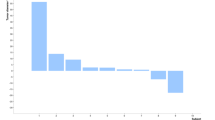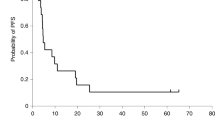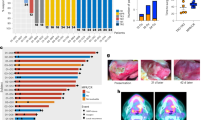Abstract
ONYX-015 is an adenovirus with the E1B 55-kDa gene deleted, engineered to selectively replicate in and lyse p53-deficient cancer cells while sparing normal cells. Although ONYX-015 and chemotherapy have demonstrated anti-tumoral activity in patients with recurrent head and neck cancer, disease recurs rapidly with either therapy alone. We undertook a phase II trial of a combination of intratumoral ONYX-015 injection with cisplatin and 5-fluorouracil in patients with recurrent squamous cell cancer of the head and neck. There were substantial objective responses, including a high proportion of complete responses. By 6 months, none of the responding tumors had progressed, whereas all non-injected tumors treated with chemotherapy alone had progressed. The toxic effects that occurred were acceptable. Tumor biopsies obtained after treatment showed tumor-selective viral replication and necrosis induction.
This is a preview of subscription content, access via your institution
Access options
Subscribe to this journal
Receive 12 print issues and online access
$209.00 per year
only $17.42 per issue
Buy this article
- Purchase on Springer Link
- Instant access to full article PDF
Prices may be subject to local taxes which are calculated during checkout



Similar content being viewed by others
References
Clayman, G.L., Lippman, S.M. & Laramore, G. in Cancer Medicine 4th edn.(eds. Holland, J.F., Frei, E.Jr., Kufe, D.W., Morton, D.L. & Weichselbaum, R.R.) 1645–1710 (Williams & Wilkins, Baltimore, Maryland, 1997).
Vokes, E.E., Weichselbaum, R.R., Lippman, S.M. & Hong, W.K. Head and neck cancer. N. Engl. J. Med. 328, 84–194 (1993).
Greenlee, R.T., Murray, T., Bolden, S. & Wingo, P.A. Cancer statistics . CA Cancer J. Clin. 50, 7– 33 (2000).
Boyle, J.O. et al. The incidence of p53 mutations increases with progression of head and neck cancer. Cancer Res. 53, 4477–4480 (1993).
Brennan, J.A. et al. Association between cigarette smoking and mutation of the p53 gene in squamous-cell carcinoma of the head and neck. N. Engl. J. Med. 332,712–717 ( 1995).
Werness, B.A., Levine, A.J. & Howley, P.M. Association of human papillomavirus type 16 and 18 E6 proteins with p53. Science 248,76– 79 (1990).
Gillison, M.L. et al. Evidence for a causal association between human papillomavirus and a subset of head and neck cancers. J. Natl. Cancer Inst. 92, 709–720 (2000).
Strong, E.W. Sites of treatment failure in head and neck cancer. Cancer Treatment Symposium 2,5–20 ( 1983).
Suit, H.D. & Westgate, S.J. Impact of improved local control on survival. Int. J. Radiat. Oncol. Biol. Phys. 12, 453–458 (1986).
Forastiere, A.A. et al. Randomized comparison of cisplatin plus fluorouracil and carboplatin plus fluorouracil versus methotrexate in advanced squamous-cell carcinoma of the head and neck: A Southwest Oncology Group study. J. Clin. Oncol. 10,1245–1251 ( 1992).
Jacobs, C. et al. A phase III randomized study comparing cisplatin and fluorouracil as single agents and in combination for advanced squamous cell carcinoma of the head and neck. J. Clin. Oncol. 10,257 –263 (1992).
Paredes, J. et al. Prospective randomized trial of high-dose cisplatin and fluorouracil infusion with or without sodium diethyldithiocarbamate in recurrent and/or metastatic squamous cell carcinoma of the head and neck. J. Clin. Oncol. 6,955–962 ( 1988).
Clavel, M. et al. Randomized comparison of cisplatin, methotrexate, bleomycin and vincristine (CABO) versus cisplatin and 5-fluorouracil (CF) versus cisplatin (C) in recurrent or metastatic squamous cell carcinoma of the head and neck. A phase III study of the EORTC Head and Neck Cancer Cooperative Group. Ann. Oncol. 5, 521–526 ( 1994).
Schrijvers, D. et al. Phase III trial of modulation of cisplatin/fluorouracil chemotherapy by interferon alpha-2b in patients with recurrent or metastatic head and neck cancer. Head and Neck Interferon Cooperative Study Group. J. Clin. Oncol. 16,1054–1059 ( 1998).
Group LHaNO. A phase III randomized trial of cisplatinum, methotrexate, cisplatinum + methotrexate and cisplatinum + 5-FU in end stage squamous carcinoma of the head and neck. Br. J. Cancer; 61, 311–315 (1990).
Kish, J.A., Ensley, J.F., Jacobs, J.R., Binns, P. & Al-Sarraf, M. Evaluation of hig-dise cisplatin and 5-FU infusion as initial therapy in advanced head and neck cancer. Am. J. Clin. Oncol. 11,553–557 (1988).
Rowland, K.M. Jr. et al. Cisplatin and 5-FU infusion chemotherapy in advanced, recurrent cancer of the head and neck: an Eastern Cooperative Oncology Group Pilot Study. Cancer Treat. Rep. 70, 461–464 (1986).
Rooney, M. et al. Improved complete response rate and survival in advanced head and neck cancer after three-course induction therapy with 120-hour 5-FU infusion and cisplatin. Cancer 55,1123– 1128 (1985).
Bischoff, J.R. et al. An adenovirus mutant that replicates selectively in p53-deficient human tumor cells. Science 274,373– 376 (1996).
Heise, C. et al. Onyx-015, an E1B gene-attenuated adenovirus, causes tumor-specific cytolysis antitumoral efficacy that can be augmented by standard chemotherapeutic agents. Nature Med. 3, 639– 645 (1997).
Hall, A.R., Dix, B.R., O'Carroll, S.J. & Braithwaite, A.W. p53-dependent cell death/apoptosis is required for a productive adenovirus infection. Nature Med. 4,1068– 1072 (1998).
Kirn, D., Hermiston, T. & McCormick, F. Onyx-015: clinical data are encouraging. Nature Med. 4, 1341–1342 (1998).
Kirn, D. et al. A phase II trial of intratumoral injection with an E1B-deleted adenovirus, ONYX-015, in patients with recurrent, refractory head and neck cancer. Proc. Am. Soc. Clin. Oncol. 17, 391a (1998).
Ganly, I., et al. A phase I study of Onyx-015, an EIB attenuated adenovirus, administered intratumorally to patients with recurrent head and neck cancer . Clin. Cancer Res. 6(3) 798– 806, 2000.
Lowe, S.W., Ruley, H.E., Jacks, T. & Housman, D.E. p53-dependent apoptosis modulates the cytotoxicity of anticancer agents. Cell 74, 957–67 ( 1993).
Lowe, S.W. et al. p53 status and the efficacy of cancer therapy in vivo. Science 266, 807–10 ( 1994).
Sanchez-Prieto, R. et al. Carcinoma cells become sensitive to DNA-damaging agents by the expression of the adenovirus E1A gene. Oncogene 13, 1083–1092 (1996).
Lowe, S.W. & Ruley, H.E. Stabilization of the p53 tumor suppressor is induced by adenovirus 5 E1A and accompanies apoptosis. Genes Dev. 7, 535–45 ( 1993).
Barker, D.D. & Berk, A.J. Adenovirus proteins from both E1B reading frames are required for transformation of rodent cells by viral infection and DNA transfection. Virology 156, 107– 121 (1987).
Wildner, O., Blaese, R.M. & Morris, J.C. Synergy between the herpes simplex virus tk/ganciclovir prodrug suicide system and the topoisomerase I inhibitor topotecan. Human Gene Ther. 10, 2679–2687 (1999).
Baxter, L.T., Zhu, H., Mackensen, D.G., Butler, W.F. & Jain, R.K. Biodistribution of monoclonal antibodies: Scale-up from mouse to human using a physiologically based pharmacokinetic model. Cancer Res. 55, 4611–4622 (1995).
Baxter, L.T., Zhu, H., Mackensen, D.G. & Jain, R.K. Physiologically based pharmacokinetic model for specific and nonspecific monoclonal antibodies and fragments in normal tissues and human tumor xenografts in nude mice. Cancer Res. 54, 1517–28 (1994).
Shisler, J., Duerksen, H.P., Hermiston, T.M., Wold, W.S. & Gooding, L.R. Induction of susceptibility to tumor necrosis factor by E1A is dependent on binding to either p300 or p105-Rb and induction of DNA synthesis. J. Virol. 70, 68–77 (1996).
Krajcsi, P. et al. The adenovirus E3-14.7K protein and the E3-10.4K/14.5K complex of proteins, which independently inhibit tumor necrosis factor (TNF)-induced apoptosis, also independently inhibit TNF-induced release of arachidonic acid . J. Virol. 70, 4904–4913 (1996).
Krosnick, J., Mule, J., McIntosh, J. & Rosenberg, S. Augmentation of antitumor efficacy by the combination of recombinant tumor necrosis factor and chemotherapeutic agents in vivo. Cancer Res. 49, 3729–3733 (1989).
Frei, E. & Spriggs, D. Tumor necrosis factor: still a promising agent. J. Clin. Oncol. 7, 291– 294 (1989).
Blick, M., Sherwin, S. & Rosenblum, M. Phase I study of recombinant human tumor necrosis factor in patients. Cancer Res. 47, 2986 (1987).
Jones, A. et al. A randomized phase II study of carmustine alone or in combination with tumor necrosis factor in patients with advanced melanoma. Cancer Chemother. Pharmacol. 30, 73– 76 (1992).
Selby, P. et al. Tumor necrosis factor in man: clinical and biological observations . Br. J. Cancer 56, 803– 808 (1987).
You, L., Yang, C-T. & Jablons, D.M. ONYX-015 works synergistically with chemotherapy in lung cancer cell lines and primary cultures freshly made from lung cancer patients. Cancer Res. 60, 1009– 1013 (2000).
Freytag, S.O., Rogulski, K.R., Paielli, D.L., Gilbert, J.D. & Kim, J.H. A novel three-pronged approach to kill cancer cells selectively: concomitant viral, double suicide gene, and radiotherapy. Hum. Gene. Ther. 9, 1323– 1333 (1998).
Wildner, O., Blaese, R.M. & Morris, J.M. Therapy of colon cancer with oncolytic adenovirus is enhanced by the addition of herpes simplex virus-thymidine kinase. Cancer Res. 59, 410–413 (1999).
Heise, C., Williams, A., Olesch, J. & Kirn, D. Efficacy of a replication-competent adenovirus (ONYX-015) following intratumoral injection: intratumoral spread and distribution effects. Cancer Gene Ther. 6, 499–504 (1999).
Acknowledgements
We thank the following individuals for their assistance on this clinical trial and on this manuscript: P. Coldiron, D. Davies, O. Diri, J. Kuhn, S. Landers, T. McCarty, V. Papadimitrakopoulou, M. Posner, M. Propst, P. Roo, L. Siu, J. Starr, K. Sultan, S. Toney and P. Trown.
Author information
Authors and Affiliations
Corresponding author
Rights and permissions
About this article
Cite this article
Khuri, F., Nemunaitis, J., Ganly, I. et al. A controlled trial of intratumoral ONYX-015, a selectively-replicating adenovirus, in combination with cisplatin and 5-fluorouracil in patients with recurrent head and neck cancer. Nat Med 6, 879–885 (2000). https://doi.org/10.1038/78638
Received:
Accepted:
Issue Date:
DOI: https://doi.org/10.1038/78638
This article is cited by
-
Emerging systemic delivery strategies of oncolytic viruses: A key step toward cancer immunotherapy
Nano Research (2022)
-
A bibliometric review of oncolytic virus research as a novel approach for cancer therapy
Virology Journal (2021)
-
Use of cell fusion proteins to enhance adenoviral vector efficacy as an anti-cancer therapeutic
Cancer Gene Therapy (2021)
-
Mesenchymal stem cell-mediated delivery of therapeutic adenoviral vectors to prostate cancer
Stem Cell Research & Therapy (2019)
-
A tumor targeting oncolytic adenovirus can improve therapeutic outcomes in chemotherapy resistant metastatic human breast carcinoma
Scientific Reports (2019)



